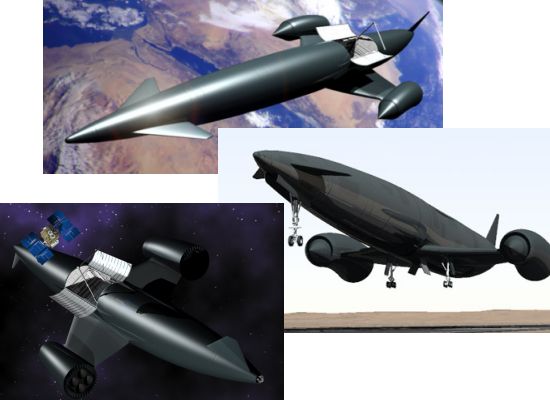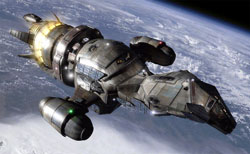At 16 I once sent a software I created use Runge-Kutta to calculate the trajectory of a rocket to orbit. It wasn't just basic beginner level stuff. It was a very accurate simulation of a multi-stage vehicle into orbit, including effects of athmospheric drag then plasma influence as the rocket aimed for a decent LEO (Low Earth Orbit).
So why not? Over the years I perused through several projects I saw. HOTOL then Space X came along, as well as CATS (Cheap Access to Space), a lesser known prize I almost applied to with a crazy friend of mine, who would store high power engine recharge units in the drawers of his appartment.
Let's compare a very realistic design i.e Skylon :
with what I saw about "Serenity"
I studied both designs and find them to be not only realistic... BUT that of Serenity is actually better!!!
Why? The bulkier shape can accommodate decently sized spherical tanks of liquid oxygen and hydrogen, giving a very good impulse.
This is 2011... so some progress has been made in taming liquid hydrogen.
It is a hellish fuel, boiling where metals are like glass, seeping through virus sized holes and exploding whenever it reaches 4% of concentration in the air... with a simple static electricity spark.
This is why a spherical tank is heaven. By design it can be in the back, while the smaller liquid O2 tank will be in the middle.
An educated guess can place the mass of such a vehicle at 300-350 metric tons while its dry mass (no fuel) will be about 50-70 tons.
Tsiolkovky's equation gives us a delta V of 1.5 to 2 X the nozzle velocity of a pure rocket acceleration of the spacecraft. Liquid H2/O2 engines have a typical velocity of 4200 m/s so delta V would be 6300-8000 m/s.
That's enough for LEO if we use the same kind of hybrid air-breathing rocket engines that SKYLON uses.
The goal here would be to make it rugged, simple, idiot proof to fly and solid enough to endure rough treatment. Besides a redundant propulsion system which would be able to tolerate a complete failure of one of the engines a few minutes into the flight.
End goal? Fly payloads to orbit or move around from one place to another in the planet within 45 min, which is within ICBM range.
The original Serenity is kind unrealistic for today's chemical propulsion abilities: 70 tons of payload? Forget it... if we have 5-10 it will be amazing.
As far as the space offered for a crew it would be just the front end. Fuel would be the rest and the 2 engines on the side also taking up the remaining available dry mass.
Well why not... I believe I have the knowledge... and for the first time in my life I saw a movie-based design that was actually realistic with what I intimately know of rocketry and astronautics.
And I am a man of action...

